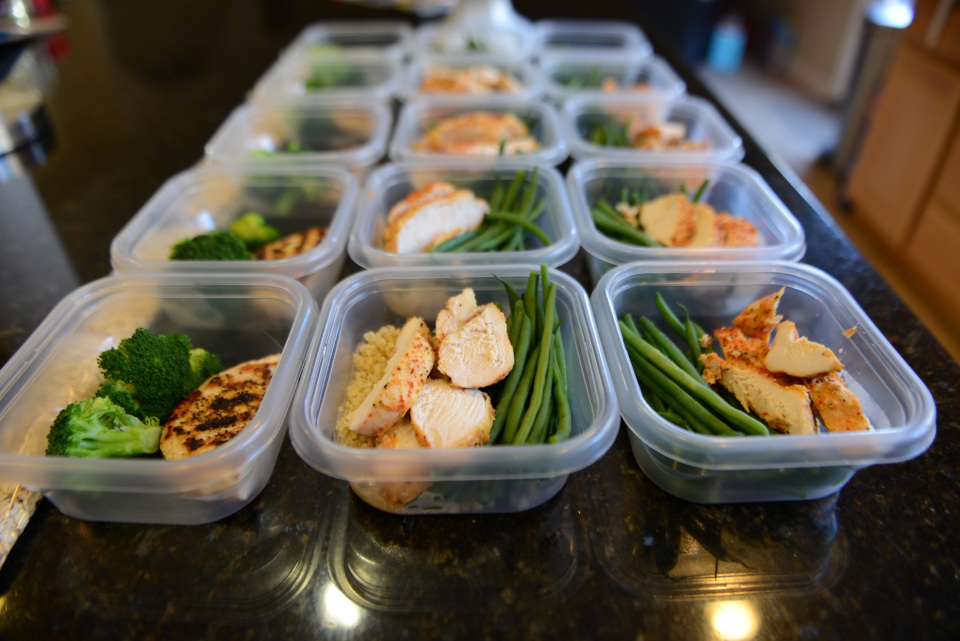
This month, we are excited to welcome back accredited dietician Serena Sullivan from Gather Nutrition. We were able to speak about food preps and kitchen staples, and whether or not preparing foods in advance was the only way forward in terms of improving one’s diet. Without further ado:
As a dietician, do you feel as though the practice of preparing food days in advance is the best way to ensure dietary compliance?
Personally, I am much more successful consuming a healthy, well rounded diet when I spend 20-30 minutes each night preparing meals/snacks as opposed to preparing them all in one go. I feel big batch cooking and a fridge full of tupperware containers can look and feel like ‘dieting’. Some people may be able to do that for a short period of time before they either become bored or they fall off the wagon due to not finding the amount of time required on a weekend.
Can cooking foods in bulk at times be a daunting prospect for someone trying to improve their eating habits?
In my experience, very much so. People can often find bulk prepping quite daunting. Many have good intentions when they set the goal of setting aside time on the weekend to do the planning, shopping, and preparing, but due to the hours this may take, it can be a challenge at times depending on the demands of family/social commitments and the like.
In saying that I have also seen clients who have made it a genuine part of their lifestyle and have sustained it for an extended period! It depends on what will suit your needs and what is a sustainable approach for ongoing success.
What are your favourite staple ingredients to include in your 20-30min prep each night?
My favourites to prepare at night will be a small container of full fat plain greek yoghurt and either a whole fresh piece of fruit or chopped fruit. I’ll always pack a variety of nuts and seeds which sometimes I’ll add to the yogurt or have separately. Its simple but you can’t go wrong with fruit and nuts. This makes for an easy snack throughout the day. I try to buy a few different types of fruit for the sake of variety.
I scale our dinner shopping to serve 4-5 people (only 2 people at home) so there is always left overs for lunches the next day. I’m always sure to have frozen vegetables, microwave rice, wholegrain bread, and some type of salad mixture, that way if dinner left overs are short on vegetables or a carbohydrate source, I can turn to these options to prepare a complete and substantial meal. Having the salad and wholegrain bread on hand usually means I will always have ingredients for a last minute salad sandwich with any vegetables if need be.
How do you ensure your clients are eating the correct portion sizes?
Whilst I educate my clients on serving sizes, I put more emphasis on making sure they are consuming enough food as opposed to food restriction. I put the biggest emphasis on the serving sizes of vegetables and try to encourage increasing vegetables servings. At the end of the day I want people looking at their meal and asking if they can see twice the amount of vegetables than they can see of protein or carbohydrates. If a meal is primarily vegetable based, it will always be nutritious and naturally lower in energy. Encouraging people to start thinking about increasing their vegetable intake (as well as increasing their intake of different varieties of vegetables) will mean they will naturally start to reduce in other areas where they may be over consuming.
I will however speak more specifically about carbohydrate serving sizes with clients who have particular health conditions, such as diabetes or insulin resistance. As a general rule of thumb, I try not too do too much food policing to give clients space to make changes on their own terms!
The Final Word with James:
Remember what may work for others is not necessarily the best option for you. Whether you are preparing your food days in advance in one hit, or doing a little preparation each night, the important thing is to have a plan of sorts. Write down some meals which you can cook, but be sure to pack your kitchen with some staples (think frozen vegetables, canned goods, microwaveable rice/couscous/quinoa, eggs, mixed leaf bags from the supermarket) incase your best intentions don’t come to fruition.
Follow Serena on Instagram @gathernutrition for more great tips!
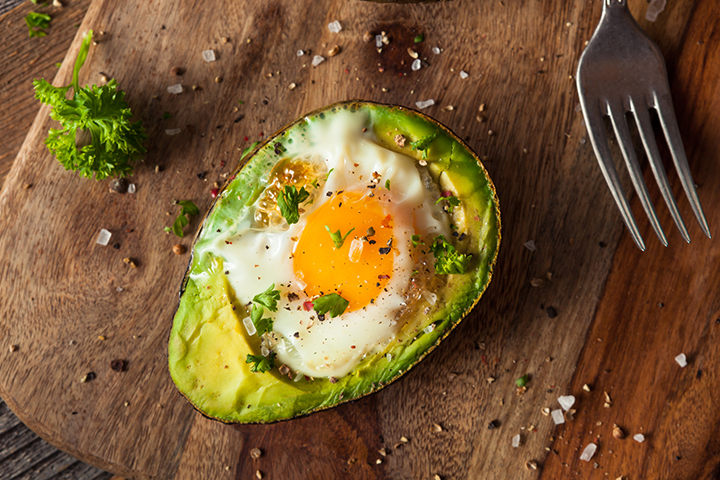
Start your day with an easy to prepare ‘protein and produce’ type breakfast, packed full of nutrients, and sugar free!
Ingredients:
- 6 avocados halved and seeded
- 6 large eggs
- salt and pepper, to taste
- 2 tablespoons chopped chives
Method:
- Preheat oven to 425 degrees F. Lightly oil a baking sheet or coat with nonstick spray.
- Using a spoon, scoop out about two tablespoons of avocado flesh, or more, as needed, creating a small well in the center of each avocado.
- Gently crack 1 egg, and slide it into the well, keeping the yolk intact. Repeat with remaining eggs; season with salt and pepper, to taste.
- Place into oven and bake until the egg whites have set but the yolks are still runny, about 15-18 minutes.
- Serve immediately, garnished with chives, if desired.
From https://damndelicious.net/2016/10/05/baked-eggs-in-avocado/
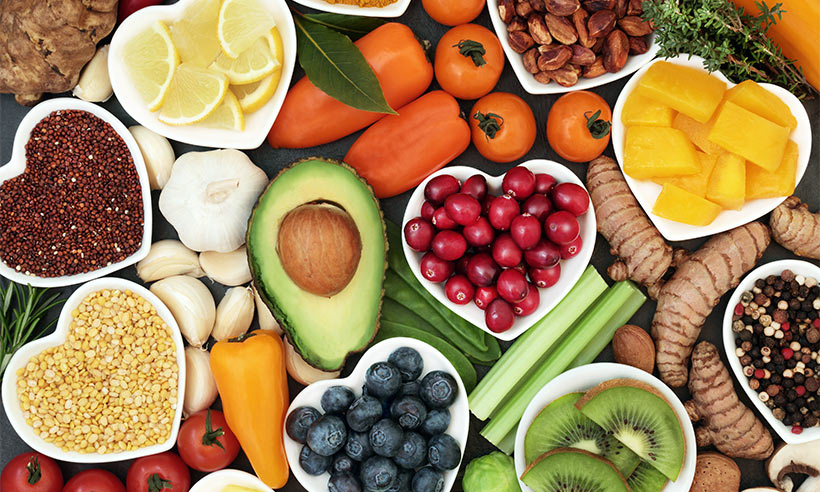
‘Veganism’. A word which is the catalyst for many debates and let’s face it, some pretty hilarious memes. However, as you have probably all noticed, the vegan lifestyle is becoming more and more popular and there seems to be an increased awareness across the board. Hopefully what follows will give you a brief insight into my life as a vegan and the effect it’s had on me, physically and mentally.
My Transition
I became vegan on the 11th of August, 2015, and I have to say it all happened pretty organically. My partner had been a vegetarian for approximately two years so my consumption of animal products had naturally reduced over that duration – but meat, eggs and dairy still made up a fair bit of my diet. She asked if I would be interested in watching a documentary called ‘Earthlings’ which looking back, was probably what started the transitioning process. I’m not going to go into the discussion of ethics – we’ve all seen the videos and anyone with an ounce of compassion can appreciate the moral justification behind veganism. Instead, I’d more like to focus on the health benefits of a plant-based diet, as this was a huge driving factor with me wanting to becoming one of those crazy extreme vegans. After viewing the documentary, I immediately dove into researching the health benefits of a vegan diet and that was “all she wrote”.
Current Diet
Now fast-forward almost 3 years and I couldn’t be happier. Now, I don’t want this article to turn into a solo episode of “This Is Your Life”, because to be honest I could talk about this stuff all day. Instead, I’ll choose three of the more significant diet-related points regarding my experience thus far with veganism.
- Micronutrients – the bottom line is that plant-based diets, when done correctly, will always result in eating a larger variety of foods. More experimentation takes part in the kitchen, more enjoyment is had with cooking, and as well as being very tasty, the meals are more colourful – and more colour means more nutrients! For example, when you’re meeting your protein requirements with foods such as beans, legumes, grains, nuts, seeds and vegetables rather than beef, chicken or fish, it’s pretty safe to say that you’re meeting many other nutrient requirements as well. Long-term, this sets you up for a far healthier and problem-free life, as you reduce your risk of chronic disease. For example, 28% of deaths in the year 2016 in Australia were a result of heart disease. A very significant factor of heart disease is atherosclerosis – the thickening and hardening of vessel walls – and a major cause of this is high cholesterol. But how many people know that dietary cholesterol solely comes from animal products, and that your liver produces enough cholesterol alone for normal bodily function? For me, the proof was in the pudding when, out of curiosity, I had a blood test in February of this year. My results were perfect, and my doctor was pretty impressed. Also, another fantastic change is that I haven’t been sick since becoming vegan, at all.
- ‘Feeling healthier’ – I have a very clear memory of 2014. I was in a ‘bulking’ phase and was consuming around 4000 calories each day. I have always strived to be the healthiest I can be, so even during this phase I was still eating plenty of vegetables and wholefoods. However, I still felt so crap. Every meal was a bigger struggle than leg day, and I was pretty lethargic the entire day. It was hard! Fast-forward to now and eating that same number of calories is entirely different. There is a noticeable difference with bloating and lethargy, and I’m generally more energetic. It’s hard to explain, but I honestly just feel healthier.
- Travelling and eating out – this is something a lot of vegan’s struggle with, but I’ve never really had a problem. Since being vegan, I’ve travelled to over 20 countries with my partner and we’ve never had an issue (thanks to wonderful apps such as HappyCow). Also, almost every restaurant has vegetarian options, and it’s never a difficult task to make these choices vegan-friendly – such as swapping out an egg or dairy product for a suitable alternative. What upsets me is hearing of complaints from the vegan community about restaurants NOT having enough vegan options. At the end of the day, veganism is in it’s infancy, and recognition on a menu in the form of a meal labelled as “Vegan” or “Vg” is a total win in my books. Recognition = awareness, and that’s the beautiful thing.
Current Training and Physical Changes
Training progress, body composition and my style of exercise have also all changed quite considerably. In addition to continuing compound strength training, I now incorporate a lot more gymnastics movements and bodyweight training into my regime and am thoroughly enjoying it. All of my personal bests for bench press, deadlifts and barbell squats have improved considerably, and I have learnt new skills such as handstands and ring muscle-ups. Could I have still achieved this as a meat eater? Probably. But, nothing feels better than going to the gym full of energy (which I didn’t always experience as a meat eater) and feeling like you can conquer anything. Also, it feels great to somewhat prove people wrong. Vegans cop a lot of flak and are always being targeted as ‘protein deficient’ or ‘malnourished’, but I’ve experienced more strength and muscle gain than ever before.
I would like to point out that I am not an expert on veganism and don’t claim to be. As I said, I strive to be well-educated and due to this point, my knowledge on diet and training is forever expanding. Also, my journey with veganism and the positive results I have experienced are just that – mine. Any diet can be done incorrectly, and individuals need to be well-educated with whatever it is they choose to consume.
Thanks so much for reading,
Matt
For information on training with Matt, contact us info@js-pt.com.au or PM us through our socials (Facebook, Instagram). For great content including vegan recipes and training videos, Matt can also be found on Facebook and Instagram.
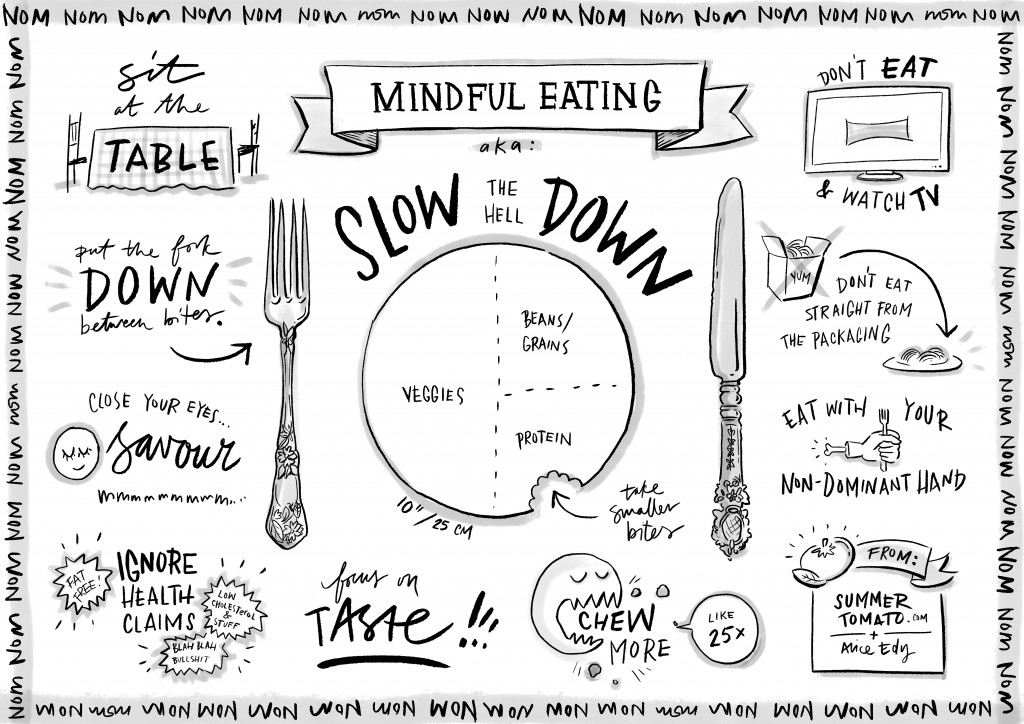
Mindful Eating – I’m sure you’ve heard the term, but do you feel like you’ve really grasped the concept? These days the term ‘Mindful Eating’ has somehow found its way into diet and weight loss programs around the world. Yet using mindful eating as as weight loss tool actually goes against what the practice of what mindful eating is truly about. Let’s break this down.
So what is Mindfulness?
Mindfulness is all about deliberately paying attention, non – judgmentally to your thoughts, emotions and physical sensations in the present moment. It’is purpose is to help free yourself of reactive, habitual patterns of thinking, feeling and acting. It is about balance, choice, wisdom and acceptance of what is.
Ok, so how does Mindful Eating fit in?
Mindful eating involves the act of non-judgmentally acknowledging your hunger and fullness cues to guide your decisions of when to begin and finish eating foods, and eating with awareness of all of your senses – sight, sound, touch, taste and smell. It helps to develop non-judgemental responses to food (likes, dislikes, neutral) while allowing yourself to become aware of the positive and nurturing opportunities available through food selection and preparation. It is a tool to learn which foods will best satisfy your hunger.
Why is it not for weight loss?
As you can see, the core purpose of mindful eating is to eat without judgement guided by your internal hunger and fullness cues. Practicing mindful eating with the intention to lose weight means that you are entering the eating occasion with expectation and judgement – to lose weight. If those expectations aren’t met, generally feelings of failure arise – which more often than not lead back to partaking in another behaviour for weight loss – which is a classic example of the diet cycle.
So how can Mindful eating help?
Eating is a behaviour and behaviour change is hard! You can follow a meal plan or pay someone to dictate to you what to eat until they are blue in the face, but at the end of day you have to learn to eat for YOU. Improving your eating behaviours is not about weighing less for a moment in time, but about learning to eat well for the rest of your life. Mindful eating can assist this in this in a number of ways:
• Reconnecting with internal physical hunger and fullness cues: We were all born with the ability to regulate our hunger and fullness internally, but as we get older and life gets busier these cues get interrupted by our environment (i.e. increased stress, working shift work, designated eating times, being preoccupied with work,). By bringing awareness to your body’s sensations around hunger and fullness, mindful eating can help you reconnect with this innate ability we are all born with.
• Reduce Non – Hungry Eating: As natural cues to hunger and fullness are explored mindful eating can help you to identify any instances of non hungry eating (i.e. eating because you are bored, stressed, depressed, lonely, procrastinating or just because it is there). Recognising these occasions is the first step to behaviour change and allows you to explore other remedies for non-hungry eating than food.
• Reduce Overeating: Awareness during eating is also key to mindfulness practice. Combined with hunger-fullness awareness this allows us to notice when a food ceases to be as palatable or as enjoyable, helping to determine when satisfaction has been reached. This is called the ‘Law of Diminishing Pleasure’.
• Increase confidence around foods we feel powerless around: We all have them, those foods that we don’t keep in the house because we don’t trust ourselves around them. Avoidance is a short term solution but long term it’s important to feel confident that you can be around certain foods without going crazy. When eating for ‘pleasure’ over ‘fuel’ – which is totally ok to do, practicing mindful eating can help us to determine when our pleasure/sensory needs have been fulfilled. For example you may buy a chocolate bar because you genuinely feel like it – in the past you might eat the whole bar because it is there, using mindful eating you may find that just half the bar satisfies you – or you may not! Only you can determine this.
How can I be a more a mindful eater? Here are 5 ways you can start with now:
- Write a definition of your hunger as if you were to put it in a dictionary- i.e. I feel… an empty feeling, gnawing and… fatigued, moody.
- Keep a hunger diary- Note down times you get hungry and any relevant circumstances around your hunger. Are you hungrier on days you exercise? Or perhaps days you have a larger workload? Less hungry on days you are stressed? Identifying patterns can help you to pack, prepare and choose foods that are more likely to satisfy your hunger.
- Give your hunger and fullness a score / 10- this is best practiced around meals you feel your overeat at (See scale below). Try to identify how much you need to stay in the comfort zone (i.e not getting so hungry you bite someone’s head off, and not getting so full that you feel unwell).
- Eat without distractions- Turn off the TV and put down the phone. Save your attention for the eating experience!
- Be curious with food, even if you have had it a million times- Before taking the first bite, ask yourself; What is the colour, texture and shape of your food like? Does it feel warm, cold or neutral? What does it smell like? Does it smell as you expected? Do different parts of it look, feel or smell different? Take a bite, but don’t chew yet! Is it cold, warm or hot on your tongue? How does the texture feel? Is it soft, smooth, dry or hard? Is it a combination? Chew slowly…How does it taste? Is is sweet, salty, or a mixture of both? Does the texture change as you chew? Does the flavour change as you chew? How does it feel on your tongue as you move it around your mouth? Now swallow…Has the taste changed again? Are there bits in your teeth? What is the aftertaste like? How is it similar or different from your first chew? Do you need more or are you satisfied?
I hope you enjoy these tips on mindful eating and remember – mindful eating is about eating without judgement and is a skill that takes practice. Start small – if you can only practise mindfulness at one meal this week that’s ok, be patient with yourself – remember behaviour change is hard.
For more on mindful eating, why not visit the Centre for Mindful Eating at www.tcme.org
Serena Sullivan
I: @gathernutrition
F: Gather Nutrition and Dietetics
W: www.gathernutritionaustralia.com
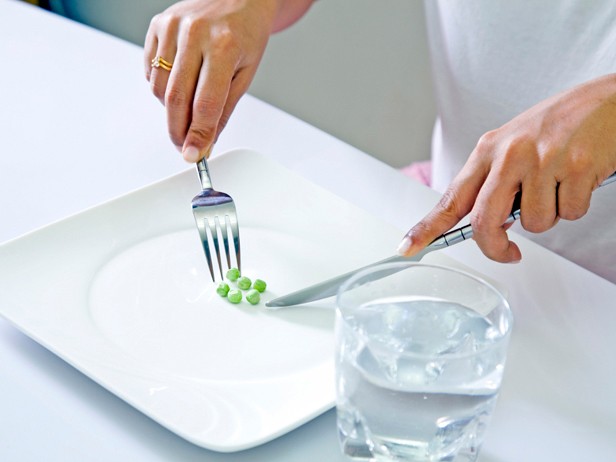
With the many diets and portion controlled meal options presented to us in this day and age, too often people are trying to sustain a diet eating far less than what is optimal for their lifestyles.
With the above point in mind, this month we share an article written by Coach Calorie which explains what can happen when you consume too little, and how much you should be eating. Without further ado:
___________________
The majority of the time when you’re having a problem losing weight, it’s not because you aren’t making good food choices. The reason why your weight loss has stagnated is because you’re not eating enough calories to lose weight.
What Happens When You’re Not Eating Enough Calories?
When most people start dieting, they slash their calories and add a large amount of exercise to their daily routine. That’s fine, but they usually cut their calories way too low. Add in the extra exercise, and all of a sudden you have an extreme calorie deficit that is working against you.
Not eating enough calories causes many metabolic changes. Your body is a smart machine and senses a large decrease in dietary energy. Your large calorie deficit might work for a few days or even weeks, but eventually your body will wake up and sound alarms that it needs to conserve energy.
It doesn’t want to just waste away. It needs that energy (fat) to survive. So, what does your body do when it senses prolonged energy restriction? Not eating enough calories…
Slows down thyroid production – Your thyroid is responsible for fat, carbohydrate, and protein metabolism, among other things. Your body has the ability to slow down thyroid output in an effort to maintain energy balance [1].
1. Decreases muscle mass – Muscle is highly calorie intensive to maintain. In a prolonged extreme calorie deficit, it is one of the first things that your body looks to get rid of, especially if you’re not providing a stimulus to keep it. Your body needs the fat, wants the fat, and the muscle can be spared. It breaks down the muscle tissue and uses it for energy.
2. Lowers testosterone levels – An important hormone for both men and women, testosterone is just one of many hormones that are affected with severe calorie restriction [2]. Testosterone is anabolic to muscle tissue. Without it, it becomes that much harder to maintain, let alone put on muscle mass.
3. Decreases leptin levels – Leptin is one of many energy regulating hormones. More importantly, it’s a “hunger” hormone that tells you whether to eat or not. High leptin levels signal that it’s OK to stop eating, while low leptin levels are a signal to eat more energy. Because of this, leptin levels decrease in calorie restricted environments [3].
4. Decreases energy levels – There are many physical actions your body takes when you’re not eating enough calories, but there are also some mental ones. Neurotransmitter production is limited, which can lead to a lack of motivation. It’s your body’s way of telling you to “slow down” – conserve your energy.
http://www.coachcalorie.com/not-eating-enough-calories-to-lose-weight/
Tracking your calories through apps such as My Fitness Pal is a great way to manage your food intake and while this is still my preferred option, this method is not for everyone. The following alternative technique requires only your hand and is explained below in this info-graphic by Precision Nutrition (PN).
Although I am a qualified PN coach, I’m of the opinion that calorie counting still has its place, which differs from PN’s opinion. But whether measuring your food intake with an app or by using the method below, the important thing to remember is tracking your food intake in some capacity will be needed if you want to start seeing results. This strategy of using your hand is a good place to start, or potentially all you need.
If you feel you need more assistance with your nutrition, contact me at james@js-pt.com.au for further options.
James

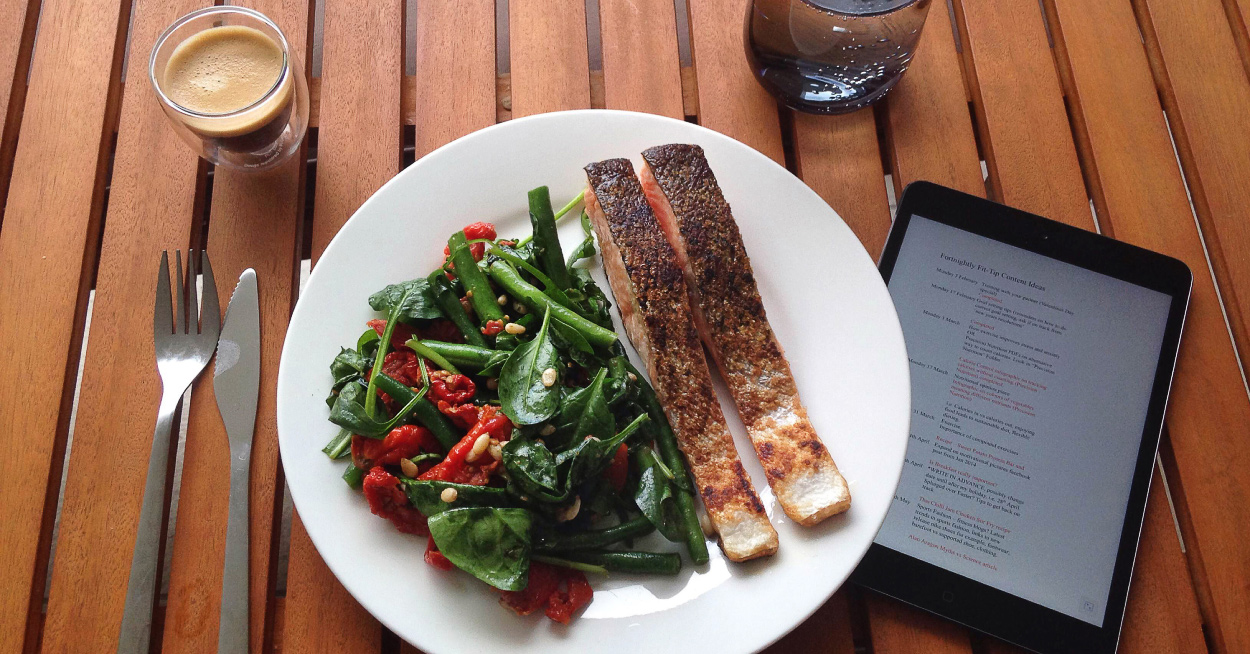
Improving your health requires changes that are sustainable for the long term. As a Precision Nutrition coach, we often provide guidance to our clients that are interested in fat loss on how to master certain food habits which will naturally lead to improved calorie control and food selection. These habits are:
1. Eat slowly and stop at 80% full
Most people (including myself) can often tend to eat their meals far too quickly, which lessens our ability to feel our hunger and appetite cues. Did you know it takes 20 minutes for our satiety mechanisms to kick in? The communication between our stomach and our brain is slow, and because of this, if we eat quickly we are far more likely to eat too much before our brain notifies us that we’re content. An excellent goal would be to aim to spend 15-20 minutes each meal. I realise this may be difficult for some so slowing down by even a few minutes will still have it’s benefits. This way, you will be able to properly gauge your fullness, which will enable you to eat until you’re ‘80% full’ which is defined as eating until you are no longer hungry, rather than eating until you’re full. This may take some practice but overall will be beneficial for your digestion, performance during your exercise, and better sleep if you’re eating before bed.
2. Eat protein dense foods with each meal
Research has shown that not only is a diet higher in protein completely safe, it may actually be important for achieving the best health, body composition (body fat % and muscle mass), and performance. The fact of the matter is, it’s hard to achieve these things with a suboptimal protein intake. By incorporating decent amounts of protein (20-30g for women, 40-60g for men) per meal, you will not only ensure you consume an adequate amount of protein, but you’ll also stimulate your metabolism, improve your muscle mass and recovery, and reduce body fat.
3. Eat vegetables with each meal
Science has demonstrated that in addition to the fibre and micronutrients (vitamins and minerals) packed into vegetables, there are also important plant chemicals called phytochemicals which are essential for optimal functioning inside our bodies. Unfortunately an inadequate vegetable intake is something I see all too often, which was reflected in Australia’s new food pyramid released earlier this year which placed vegetables (as well as fruit and legumes) as the food group we should consume the most. Given only an estimated 7% of all Australians reach their recommended intake of vegetables per day, it is something we should all aim to improve on. Including two servings of vegetables/and or fruit during each meal, not only will you regulate your overall food intake but you will also be receiving the many disease fighting benefits that vegetables provide.
4. Eat healthy fats daily
As a general rule of thumb, about 30% of your diet should come from fat, although this can change between each individual. Whilst you should focus on adding monounsaturated (extra virgin olive oil, some nuts, avocados, red meats, eggs) and polyunsaturated (some nuts, some vegetable oils, fish/fish oil) fats, including some saturated fats is ok too as a balance of all 3 types of fat is optimal. The benefits of dietary fat include the balancing of hormones, increased brain and nervous system health, and improved metabolism.
Mastering these four habits are simple and sustainable ways to improve your overall health, body composition, and performance, as your calorie control and food selection will be greatly improved.
(Inspired by the Precision Nutrition Certification Manual)
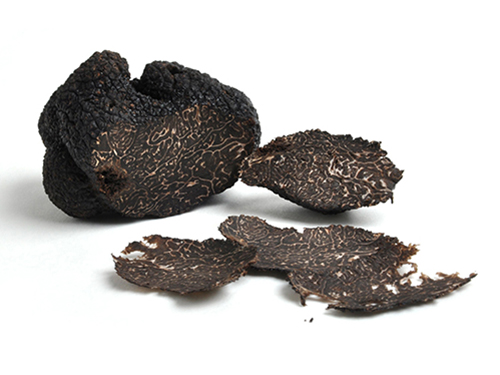
A fungus that grows underground due to a relationship with hazelnut or oak trees and soil, which is found by the keen smell of a trained dog, and can cost as much as $3000 per kilo. What?
Lucky enough for us, we can buy truffles by the gram for $2 at Superior Fruit in Graceville, but what do we do with them?
Truffles are used mostly to enhance and intensify foods by shaving as thinly as possible, to cover a wider area of food to help create a greater aroma. Best used over simple foods such as eggs, mushrooms, chicken, pasta, and potatoes, while some chefs may challenge the status quo and surprise in a delicious way with their use of truffles.
Given the small amounts of shaved truffle you would use to flavour a dish, the nutritional benefits are limited, but they are known to be a good source of protein given they are from the mushroom family.
As always, remember fresh is best!
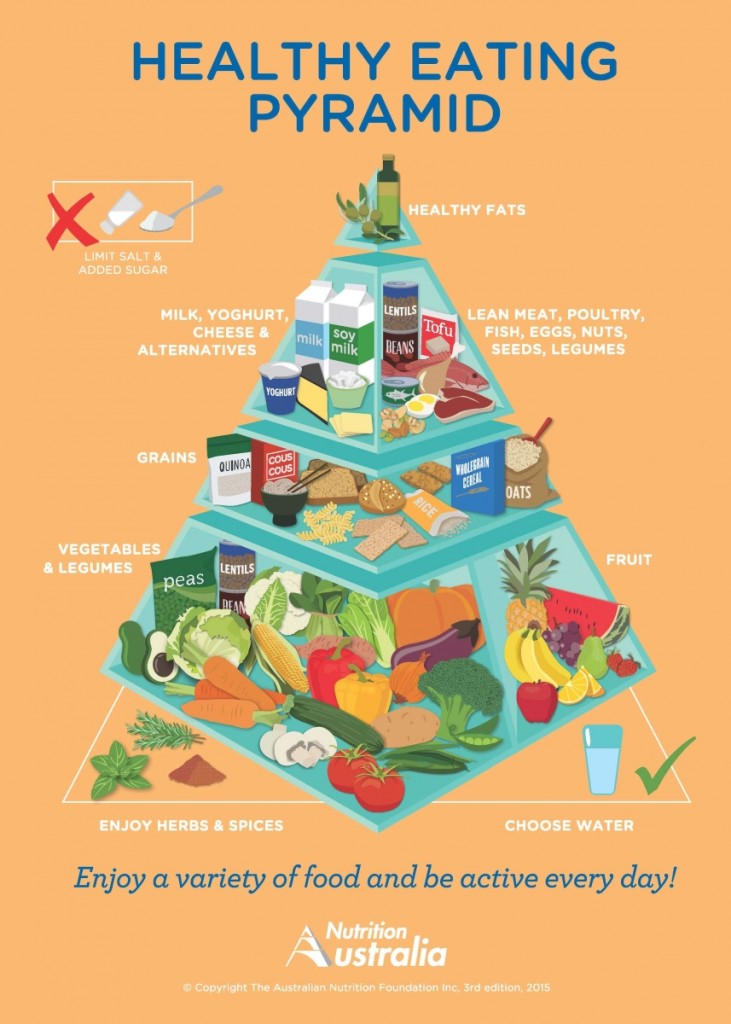
Making sense of what exactly is good and bad nutrition is a tough gig for most people. You could bet your bottom dollar that for every piece of information you find on what you should do, there will be a counter argument somewhere as to why you shouldn’t do it. Thankfully, Nutrition Australia finally released it’s new and revised food pyramid last month which aims to clear things up. Let’s take a closer look:
1. Vegetables take centre stage
The bottom layer of the food pyramid is now predominantly vegetables as well as legumes and fruit. With the high amounts of vitamins and minerals present in these foods, they have been linked to a reduced risk of a number of serious diseases such as cancer, heart disease, and type 2 diabetes.. Vegetables and fruit are also high in fibre which helps with weight control. Given an estimated (and shocking) 7% of Australians reach the recommended daily intake of vegetables, this is a good start to the new pyramid.
On a side note, while both are good options, still aim to eat more vegetables than fruit.
2. Include healthy grains
The renamed carbohydrates group has shifted up from the bottom of the pyramid to put more emphasis on Australians eating more vegetables. Carbohydrates, even with their bad reputation these days, are essential in a healthy diet and the new pyramid encourages (whole)grains such as quinoa, brown rice, multigrain breads, and oats which are also all rich in fibre. That being said, other carbohydrate options such as white rice are not poor options and can easily be included in a well balanced diet.
3. Have a mix of different sources of protein
The second top layer emphasises consuming a variety of protein sources from dairy, meat, and non meat products. While red and white meats are the obvious choices of protein, people often forget dairy products (such as cottage cheese and greek yoghurt; whey protein powder also falls in this category) are also rich in protein as well as being high in calcium.
Consuming a mixture of fish, nuts, and seeds will not only give you variety in your protein, but will also help you reach your recommended intake of healthy fats.
4. Fat is good
Fats are often neglected but they have major roles in the body which include manufacturing and balancing hormones and improving brain and nervous system health. A mix of monounsaturated and polyunsaturated fats are ideal for optimal health. They can be found in oils, avocados, nuts and seeds, fish, and eggs.
5. Junk food has been canned
The previous food pyramids had junk food at the top in the ‘eat in small amounts’ category, and whilst I think the amended food pyramid is much better, I will say that eating a small percentage (under 10% of your daily intake) on whatever you wish will not have an effect on your overall body composition and will also help you control cravings. For the average person though, not having the junk food option on the pyramid is the correct stance.
All in all, Nutrition Australia has done well with the updated version of the food pyramid. For the average person, it is a good starting point to refer to and if followed consistently would definitely improve the current eating habits of Australians unfamiliar with good nutrition practices. Putting more emphasis on vegetable intake is a much needed addition to the pyramid, and is definitely one aspect of nutrition which is hard to disagree on, regardless of what your good and bad nutrition stance is.
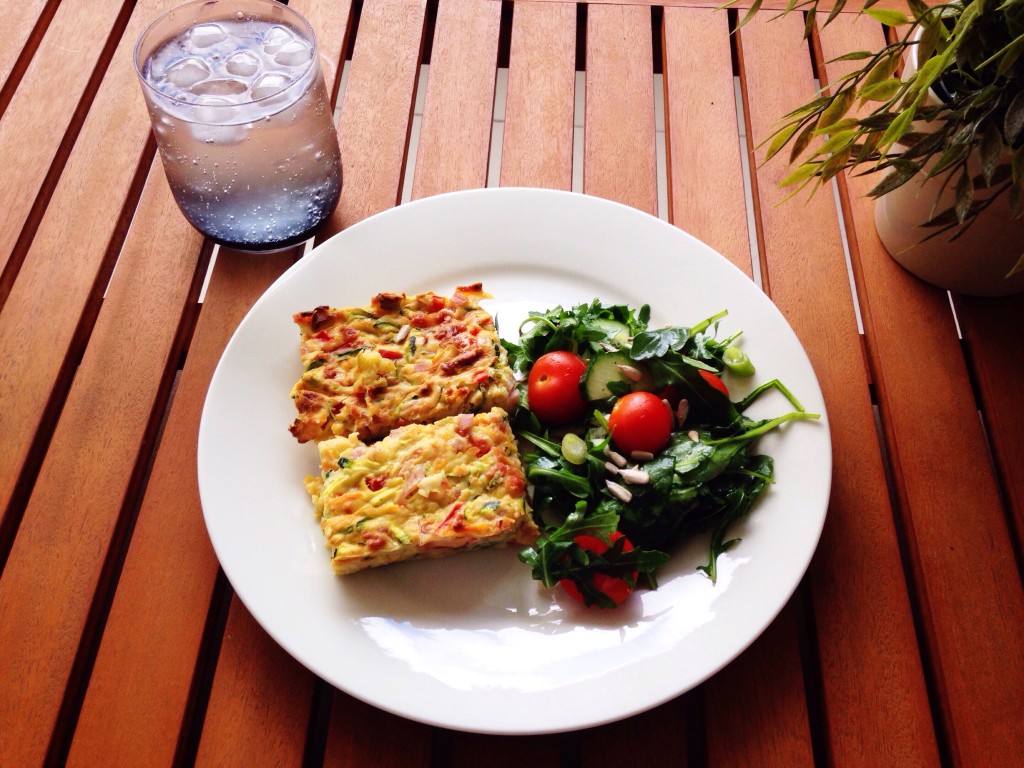
Zucchini slices are a great way to add more vegetables into your overall diet, especially when served with a side salad. They make for a great lunch, dinner, or snack, and are perfect for your weekly food preps. One of my personal favourites!
—
Ingredients:
2 zucchinis
4 eggs
2 spring onions thinly sliced
1 carrot
1 red capsicum
175g packet of short cut bacon
1 cup self raising flour
1 cup grated cheese of your choice (this was mozzarella)
1/4 cup milk
2 tablespoons extra virgin olive oil
Side salad: baby spinach, rocket, cherry tomatoes, spring onion, sunflower kernels
Method:
- Pre heat oven to 180 degrees. Grease a 20cm x 30cm lamington pan and line the base and 2 long sides with baking paper.
- Place the zucchini, carrot, capsicum, spring onion, bacon, cheese and flour in a large bowl and stir to combine. Add the egg, milk and oil and stir to combine. Season with salt and pepper.
- Spoon the mixture into the prepared pan and smooth the surface. Bake for 40 mins or until firm to the touch. Set aside to cool. Cut into squares. Serve with side salad
(from taste.com.au)
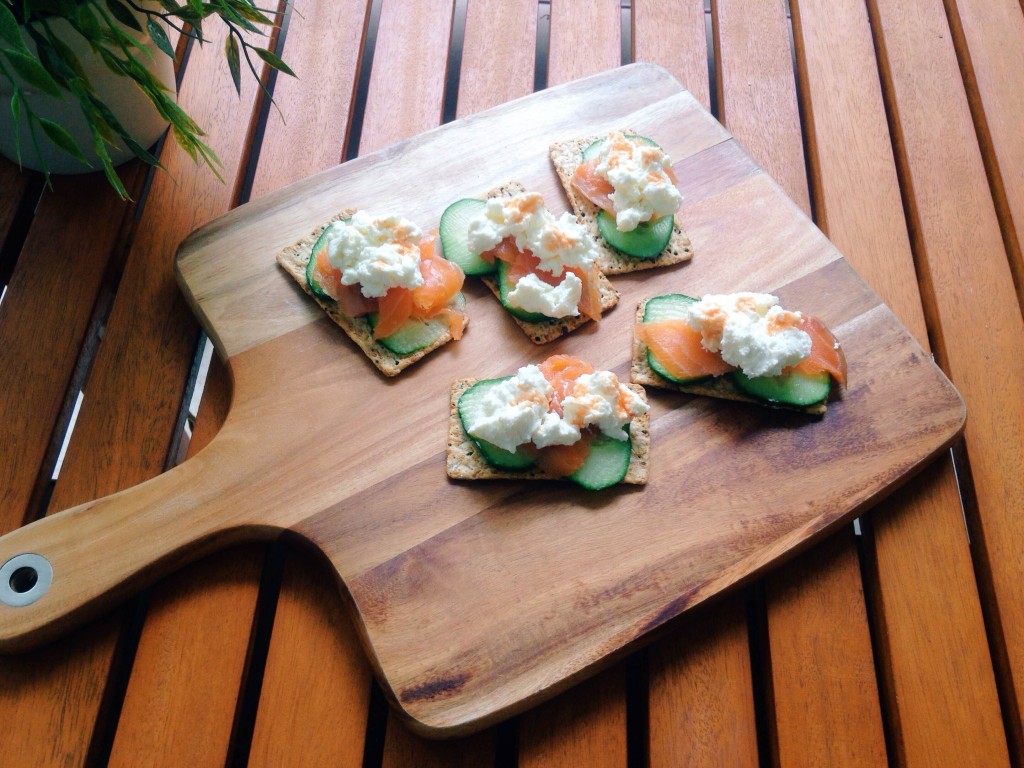
This was an enjoyable afternoon snack for me last week; vita wheat crackers with cucumber, smoked salmon, cottage cheese with some cracked pepper and Tabasco sauce.
Vita wheat crackers are wholegrain based so provide a good source of fibre and carbohydrates, while the smoked salmon contains B vitamins and minerals such as magnesium and selenium which aid your metabolism. Cottage cheese is not only a complete source of protein, but also is a great source of calcium which is crucial for bone health.
Change your serving size to suit your personal needs and enjoy!
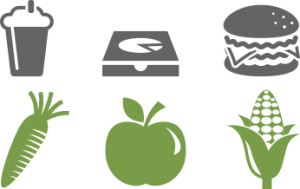
I’m all for people starting small on their health goals, and gradually building to bigger things. Whether they are starting with smaller goals, or starting on smaller day in and day out habits, it all helps. Something is better than nothing right? However, are you someone that has made smaller changes in your exercise and eating patterns in order to lose weight, but still feel like you are going nowhere? This post may be for you.
Let’s start with some common small changes people make to help achieve weight loss goals:
– Drinking low fat milk instead of full cream milk
– Swapping sugar for stevia/sweetener in your coffee
– Eating only wholegrain versions of different foods (i.e. Brown rice, or multigrain bread)
Whilst changing certain habits each day may help, too often people are caught up in the minor changes, and not focusing enough time on the major things that would be most beneficial. This is what I call ‘majoring in the minors’.
Solely changing to low fat milk or eating more wholegrain foods isn’t going to make a difference if you are not eating less calories overall. The energy balance equation is what matters:
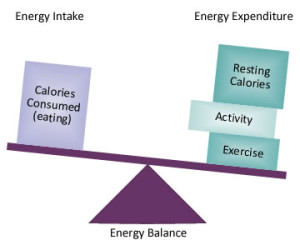
If you consume more than your maintenance calories each day (regardless of milk type, or whether wholegrain or not), you will put on weight. If you consume less, you will lose weight. So how do you measure your food intake? Track your food intake with an app like My Fitness Pal (as spoken about on a previous post here).
Needless to say, I still recommend that 80-90% of your food intake comes from whole and minimally refined foods for health reasons, and wholegrain foods are an important component in your diet due to their fiber content. But overeating is overeating regardless of the food type, so remember to keep focused on major changes such as controlling your overall food intake and overall activity level rather than minor changes, and I assure you this will make a bigger difference.
For specific nutrition coaching plans, feel free to email me on james@js-pt.com.au for any enquiries.












